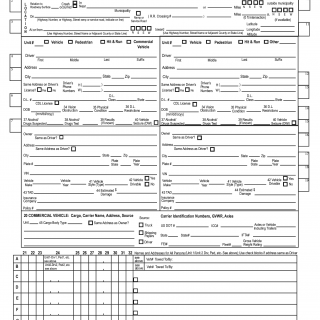Form DMV-349. NC Crash Report Form
The Form DMV-349, also known as the Crash Report Form, is a crucial document used in North Carolina to report motor vehicle crashes that meet specific criteria. Its main purpose is to gather essential information about the incident for documentation and analysis purposes.
The form consists of several sections that need to be filled out accurately. It is important to note that if a section does not apply to the particular crash, it should be indicated by drawing a diagonal line through that section. The following details should be provided when filling out the form:
-
Identification: This section requires basic information about the crash, including the date, time, and location of the incident.
-
Involved Parties: Information about the involved parties should be provided, such as the drivers' names, addresses, contact numbers, and driver's license numbers. Additionally, it may require details about insurance companies and policy numbers.
-
Vehicles: This section focuses on the vehicles involved in the crash. License plate numbers, make, model, year, and VIN (Vehicle Identification Number) should be recorded. If any of the vehicles were seized, additional information regarding the seizure would need to be included.
-
Witnesses: If there were any witnesses to the crash, their names, addresses, and contact numbers should be documented.
-
Crash Narrative: A detailed description of the crash should be provided in this section. It should include information about how the incident occurred, contributing factors, and any other relevant details. This narrative plays a crucial role in understanding the sequence of events leading to the crash.
When filling out the form, it is important to adhere to the following guidelines:
- Typewritten or handwritten reports must use black ink for legibility.
- Ensure the report is legible as it will be imaged for later storage.
- Submit the original copy of the form to the DMV Traffic Records Section.
Strengths:
- Comprehensive: The form captures vital information about the crash, parties involved, and vehicles, providing a comprehensive overview of the incident.
- Standardized: The DMV-349 ensures consistency in reporting motor vehicle crashes across North Carolina, making it easier for analysis and comparison.
Weaknesses: Potential Human Error: Being manually filled out, there is a risk of human error, leading to inaccuracies in the reported information.
Opportunities: Data Analysis: The collected data can be analyzed to identify trends, patterns, and areas where improvements are needed to enhance road safety.
Threats: Incomplete or Inaccurate Reporting: If the form is not completed accurately or some sections are left incomplete, it may hinder the effectiveness of analyzing the crash data.
Submitting and Storage: The original copy of the completed DMV-349 form should be submitted to the DMV Traffic Records Section. It is likely stored electronically in a database for future reference and analysis by the authorities.
Related and Alternative Forms: Similar crash report forms may exist in other states or countries, although they might have different names or slight variations. It is important to review the specific requirements of each jurisdiction when reporting a motor vehicle crash outside of North Carolina.
Impact on Participants: Completing the DMV-349 form accurately and promptly ensures that the relevant authorities have access to vital crash data. This data helps shape policies, improve road safety measures, and provide support for accident investigations and insurance claims.
Overall, the DMV-349 Crash Report Form plays a crucial role in documenting and understanding motor vehicle crashes in North Carolina. By providing detailed information about the incident, it contributes to promoting safer roads and improving the overall transportation system.

